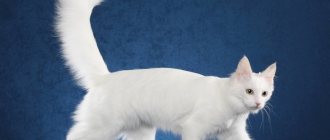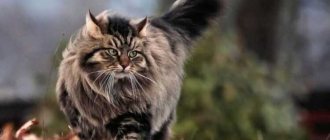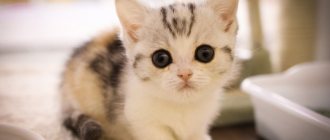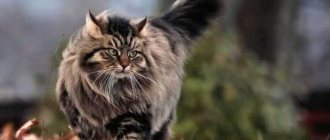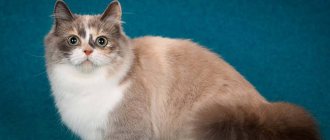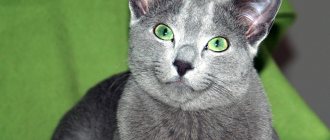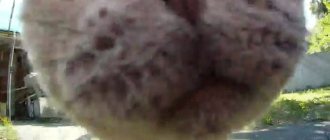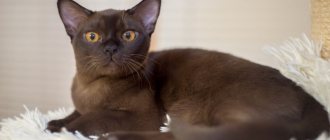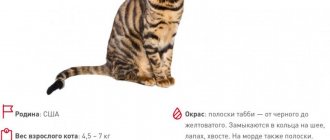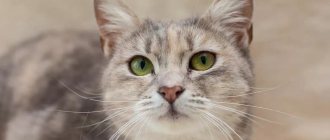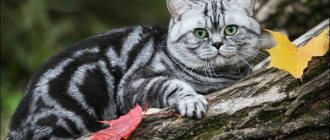An unusual and interesting breed of cat is the Munchkin. Its peculiarity is its short legs. Most people, when they first look at an animal, have a feeling of pity, but in vain!
Despite the peculiarity of their paws, cats lead an active and cheerful life. It is thanks to its disposition that the Munchkin breed has gained great popularity throughout the world.
Origin story
Munchkin cat breed People
first started talking about this breed in the 30s. last century. But the outbreak of the Second World War temporarily put an end to these unusual animals and their owners. Only in the 80s. The Munchkin revival has begun. This happened by pure chance. One American woman adopted an unusual kitten with short hind legs. Having become an adult cat, he gave birth to the same kittens.
The veterinarian became interested in the unusual offspring. He suggested that the owner show them to phenologists in order to register them as a new breed. There were also a lot of people willing to start breeding. For the first time these cats began to be exhibited at shows in 1991. And after a little time they gained worldwide fame. The general breed standard was established at the beginning of the 21st century, which is still valid today.
They began to actively import it to Russia in 2002. Initially, such cats were considered exotic. Now they are bred in many nurseries located in large cities and short-legged pets are no longer something outlandish.
The breed owes its name to the characters from the children's book “The Wizard of Oz” by the American writer Frank Baum. They were a fabulous people of short stature, distinguished by their peaceful and cheerful disposition.
How did the Munchkin breed originate?
Short-legged cats were created through natural mutation, so most of them have good, strong health. The first mentions appeared in the 30s of the twentieth century. But the Second World War practically destroyed this genetic line.
But after graduation, dachshund cats were spotted in America and Soviet Russia. In the USSR they were called “Stalingrad kangaroos” because of their ability to sit on their hind legs. There were suggestions that the breed appeared due to difficult living conditions.
Officially, the history of munchkins began in 1983, when music teacher Sandra Hochenedel from Louisiana (USA) discovered a pregnant cat with short legs and named her Blackberry. Half of her kittens were short-legged, which greatly surprised the owner. She gave an unusual pet named Toulouse to her friend Kay LaFrance.
Blackberry and Toulouse were later examined by a doctor who informed the women that the breed was a natural occurrence. The mutation does not harm health in any way and does not lead to problems with the spine, as in short-legged dachshunds.
As a result of long disputes, munchkins were recognized only in 1995. They received their unusual name in honor of the dwarf people with a cheerful disposition who lived in Lyman Frank Baum’s fairy tale “The Wizard of Oz.” Now these kittens are bred all over the world. At the beginning of the 21st century, this breed was brought to Russia.
Description of the Munchkin breed
Fluffy “dachshunds” have an average body size, while their paws are shortened by 2-3 times. They are often crossed with other breeds, and the offspring are long-legged. Such children do not participate in exhibitions; they are bred to maintain the viability of the offspring. Having two short-legged parents increases kitten mortality.
Munchkins are medium-sized cats, the weight of an adult animal is 2-4 kilograms. The eyes are almond-shaped, there is no connection with the color of the coat, like in the fold breed. The ears are slightly rounded at the tips, set wide and high. Longhairs have tassels.
Do not miss
- Do not miss
Scottish fold cat: photo, character and characteristics of the breed
Based on their paws, they are divided into three types: regular, short, and very short. The legs are proportional, curvature is not allowed. The length of the tail is equal to the body, and rises upward when walking. The coat is semi-long with undercoat, soft to the touch. Any color, often two-tone. Life expectancy with good care is 15-20 years.
Brief description of the breed
The description of Munchkin cats should begin with short legs - this is their distinctive feature. This feature arose as a result of a random gene mutation. The spinal column was not affected, remaining as flexible as in normal cats. Despite their short legs, they are extremely active in movement and quick.
Munchkins have a very elongated body
They also stand out for their elongated body (like a dachshund). There are short-haired and long-haired representatives.
By nature, they are one of the most peaceful and affectionate cats. They cannot exist without constant communication with people.
Description of the munchkin cat
Despite the presence of short legs, these animals have a classic spine, the flexibility of which is not inferior to cats of other breeds. We can safely say that short legs do not have a negative impact on the cat’s behavioral abilities and mobility, providing it with comfortable living conditions. Munchkins are not only characterized as original animals, they are quite intelligent and very easy to handle cats, regardless of the length of their coat.
MUNCHKIN - INTERESTING FACTS ABOUT THE BREED
Breed standards
Another peculiarity of the breed is that the cat has a non-protruding chest bone, as well as a medium-sized nose. Breed standards are also presented:
- A head that is wedge-shaped, but with smooth outlines, as well as a flat frontal part, a medium-sized muzzle, a slightly rounded nape, moderate or high cheekbones, with a chin that is quite strong, but at the same time it is wide, although it protrudes slightly.
- Ears that are set wide and high, the tips of which are rounded, while at the base they are widest.
- The eyes are walnut-shaped or almond-shaped, relatively large in size, widely set. The eyes are open and expressive, while in relation to the line of the ears they are located at a slight angle. Eye color is even and rich.
- The neck is of medium length but thick, firm and muscular, without much thickening.
- An elegant and slightly elongated body, also of medium size, while it seems to rise in the direction from the withers to the croup area. The hind limbs are slightly longer than the forelimbs, while the body is muscular and strong. The hips are straight and the chest area is slightly rounded.
- The tail part, which tapers towards the tip, is proportional to the rest of the body.
- Forepaws, which are of equal thickness, but have a slight, permissible inward curvature.
Short-haired representatives of this breed are distinguished by medium-sized wool, the structure of which resembles plush and shiny. The undercoat is characterized as moderately developed. Long-haired individuals are characterized by the presence of semi-long wool, while its structure is silky, but very dense, while the undercoat is not very developed. The collar area has some highlighting against the general background.
Important point! These cats got their unusual name thanks to the mythical people described in the work “The Wonderful Wizard of Oz.”
The lower part of the body is covered with a longer and more fleecy coat with excellent protective characteristics. Adult cats have a more developed head and clearly visible fangs. TICA allows crossing both long-haired and short-haired individuals with each other, as well as with domestic cats that have a similar appearance and quite interesting exterior.
Munchkin character
These animals simply have a wonderful disposition, since they are peaceful, quite sociable and loving cats. Despite the apparent gentleness of their character, these cats can easily stand up for themselves. These are cheerful and active living creatures that can cheer up all family members, regardless of their age. Even with age, the cat does not lose either mobility or curiosity, maintaining its sociability.
A peculiarity of the behavior of munchkins is the fact that cats are able to litter some secluded places. These places are created due to the disappearance of objects from time to time, which ultimately end up in the hiding places of these cats. These cats quickly get used to changing conditions, to the presence of guests or other animals in the house. Munchkins are happy to walk with their owner on a leash. Cats of this breed do not show aggressiveness and do not have rancor; they behave neatly and cleanly.
How long do munchkins live?
Under conditions of proper organization of home care, associated with a proper diet and a full range of preventive measures, “short-legged” cats can live for about 2 decades at most.
Munchkin cat
Breed standard
Purebred Munchkinis must meet the same characteristics
| Head | In the form of a modified wedge with rounded contours. Proportional to the body. Cheekbones – clearly defined, protruding (more in males than in females). |
| Ears | Wide at the base, slightly tapering at the top and forming rounded tips. Sizes range from medium to large. Tassels are allowed. |
| Eyes | Large, shaped like a walnut. The outer edges are slightly raised towards the ears. Planted at a considerable distance from each other. |
| Muzzle | Compact, pretty. The chin is well developed, powerful, protruding forward. The forehead is flat. |
| Nose | Medium in length. The standard allows minor deflection. |
| Neck | Thick, muscular. Males are shorter than females. |
| Frame | Long, loose. The back line has a slight slope from the shoulders to the tail. The chest is round, the hips are dense. Cats look more graceful than cats. |
| Paws | 2-3 times shorter than other cats. The back and front are the same in length. The pillows are round. |
| Tail | Voluminous throughout, tapering only towards the tip. When the cat moves, it is in a standing position. The length corresponds to the size of the case. |
The correct Munchkin breed standard.
Disadvantages are:
- strongly protruding sternum;
- nose too short or long;
- round eyes;
- stocky build;
- curly fur;
- saggy croup
Such individuals are subject to disqualification.
About the breed
In the photo, Munchkin cats are easy to recognize due to their anatomical features. Apart from the length of their paws, these animals are no different from their other counterparts.
There are three types of cats of this breed: standard, dwarf and ultra-short-legged.
Distinctive features of the breed:
- Strong, muscular, elongated body.
- Small, widely spaced ears.
- Thick and soft fur, which can be short or long.
- Big eyes, with a slightly surprised look.
- A long tail.
- The weight of the female is 2-3 kg, the male – up to 4.
- The color can be very diverse. It can be plain or spotted with stripes.
Munchkin colors
They do not have an unconditional list of colors. The standard does not prohibit different colors. This is due to the natural origin of animals, and not through artificial breeding.
At exhibitions you can see such cats of various colors:
- rich red;
- gray;
- white;
- chocolate;
- marble;
- black.
Unusual color of the breed
A combination of several colors, as well as the presence of spots and stripes, is allowed.
Since the breed is still experimental, it is allowed to breed cats of any color. But there are plans to develop uniform color requirements by 2025.
What to feed
Animals are not picky eaters, but still require careful selection of foods in their diet. Dry and wet food of the highest quality, or natural products are suitable for them.
They are allowed to give: lean meat, white fish, cereals, eggs and vegetables.
The following should not be included in the diet: bread, potatoes, salty soup, canned food and pasta.
Genetics of Munchkin birth
The exact reason for the Munchkin's short legs has not yet been established. This mutation occurred spontaneously and did not affect other organs of the animal. Of course, breeders do not deliberately inhibit the growth of limbs with the help of special medications and other methods.
The gene responsible for this feature is selectively inherited by cats. So a litter can have kittens with both short and long legs. Work on studying the unknown gene is still underway. American scientists are especially active in this. They published the results of their many years of effort in the BioRxiv electronic repository.
Buy a munchkin
As noted above, cats of this breed appeared with us not so long ago. Despite this, this breed is bred by many experienced breeders, as well as nurseries, so purchasing a kitten of this breed is not associated with difficulties.
What to pay attention to
Purchasing a kitten is associated with a number of features. Particular attention should be paid to visual inspection of the animal, as well as the parent pair. It is better to observe for some time the behavior of the animal, clarifying some points:
- Age of the parent couple.
- The number of their matings.
- The presence of diseases they have suffered.
- Presence of hereditary diseases.
- Difficulty of pregnancy and childbirth.
- Presence of kittens with extra toes in the litter.
- Availability of vaccinations, as well as deworming procedures.
- Carrying out activities for sterilization or castration of kittens.
- The behavior of the parent couple.
- Method of feeding kittens.
- Features of keeping cats of this breed at home.
When purchasing a kitten from a responsible breeder or nursery, a potential client has the right to receive information regarding raising a munchkin at home. It would be useful to remind you that the kitten must be accompanied by all the necessary documents indicating its pedigree origin.
Munchkin kitten price
A kitten of 3 months of age with confirmation of purebred, but without accompanying documents, can cost a maximum of 6 thousand rubles. If the kitten has a package of relevant documents, then you will have to pay 2 times more for it. The cost of kittens sold in nurseries of the highest level is set on the basis of a special expert commission.
Character of the breed
Munchkins have a very elongated body.
These toy creatures are devoted to their owner, like dogs. Curiosity and innate restlessness do not allow them to lie or sit quietly. They will participate in all household chores. They love it when a lot of attention is paid to them, but they themselves do not persistently ask for affection.
The friendliness and excessive contact of the Machkins allows them to find a “common language” with children. Cats are always ready to take part in games and have fun. At the same time, claws and teeth will never be used. They get along with other pets in the house without any problems. Love extends to all family members, but the owner is always the priority. It is with him that the pet develops closer communication.
Representatives of this breed are naturally intellectually developed. From the first time they learn the rules of living in the house and follow them unquestioningly. Therefore, there are no problems with training to use the tray and scratching post.
If you treat your pet kindly, the positivity and friendliness in his character does not decrease over the years. Even at an old age, they will surprise you with their agility and funny antics.
The paradox is that despite their short legs, cats move quite nimblely and deftly jump where they need to. It's true that they sway slightly when moving. Another feature of the Menchkins is silence. They meow rarely and quietly.
Munchkin character
Short-legged cats have a light and cheerful character. They get along well with other pets and children. They love to play and can run for a long time and hunt for a wind-up mouse.
The nature of the munchkin makes it possible to have it as a pet even in families with babies. Despite their sufficient activity and curiosity, they are very good-natured and devoid of aggression; they will not scratch a child even if they are in pain.
The Munchkin does not jump due to his anatomy. Such cats play pranks in the lower areas of the home. It should be noted that they love to hide small trinkets in their house or secluded corners of the apartment.
An interesting feature of the breed is its sitting style. The cat sits in a column on its butt, maintaining the balance of its body with the help of its tail resting on the floor. At these moments, the pets, thanks to their short front legs, resemble a kangaroo in appearance.
Caring for Munchkins
Proper care will ensure the health of your pet.
From an early age to old age, Munchkins remain clean cats. They strictly use the litter box, do not throw litter around and eat food carefully. But they don’t particularly like water, so bathing them is not easy. Despite this, bathing procedures should be performed at least twice a year - in spring and autumn. Use cat shampoo. When bathing your pet, try to prevent water from entering the ears. nose, eyes. Then the animal is wrapped in a towel or dried with a hairdryer on low temperature.
Systematically examine the eyes and ears for the presence of purulent accumulations. If they are observed frequently, consult a veterinarian. Otherwise, remove them yourself with a damp cloth or cotton pad soaked in warm water. Claws are trimmed as they grow with a special tool (sold in a pet store). Additionally, a scratching post is installed in the house.
For a short-legged pet, you need to equip a separate play corner. It contains several devices for climbing, sharpening claws and various fun things. It is necessary to have toys, otherwise the cat will use any found objects for entertainment.
Diet
Each owner chooses the diet for Machkini individually. This can be industrial feed or natural food. In the first case, it is better to buy premium food that contains all the important nutritional components for the development and growth of your pet.
Natural nutrition should be balanced. The meat is taken exclusively of high quality and fresh. So, fatty pork is strictly prohibited. It is recommended to give your cat chicken, beef or veal (boiled). You also cannot throw bones, be they meat or fish. The menu must include fresh vegetables (raw and boiled).
It is not allowed to use salt when preparing dishes. Sugar is also contraindicated for them. Fatty foods are also kept to a minimum, since cats are prone to rapid weight gain.
The following products are contraindicated:
- mutton;
- legumes;
- any cereal.
A kitten should not be taught to eat from a common table.
Babies are fed up to 5 times a day, adult cats - 2 times. If you pamper your pet with food more often, then literally before your eyes he will become fat.
Care and hygiene
Munchkin cats are extremely clean and quickly learn to use the litter box. It is advisable for them to choose a toilet with high sides or a closed one. Caring for and maintaining a short cat is not particularly difficult. It is enough to wipe your ears with it a couple of times a month and regularly wipe your eyes. If you wish, you can trim your claws, but these pets rarely damage furniture; a scratching post is enough for them.
Short-haired cats need brushing once a week, and a little more often during shedding. Long-haired dogs will need to be brushed a couple of times a week and daily if they shed. It is worth noting that hairs are easily removed with a furminator.
For the safety of your pet, it is advisable to remove all potentially dangerous objects higher up.
What to feed a munchkin
The Munchkin cat is a big fan of food, so it often suffers from excess weight. The owner should monitor the calorie content and portion size. It is also important to remember that the breed needs predominantly protein foods. If an industrial type of food has been chosen, then preference should be given to specialized premium and super-premium food.
Natural nutrition should consist of lean meat, for example, veal, chicken, turkey. You can give rabbit meat, sometimes sea fish and eggs. All food should be given to the cat ready-made without salt. You can add a small amount of vegetables and cereals to your diet.
A kitten should eat at least 6 times a day; an adult cat needs 3 meals.
Education and training
These easily trainable cats,
Munchkins are famous for their intelligence, so training them is not difficult. They understand the command perfectly and carry it out. This also applies to toilet training your pet. The main thing is not to resort to forceful methods of influence or shouting during training. This will lead to the pet becoming afraid of the owner and definitely not learning anything.
If you want to train your pet to perform different tricks, you need to start early. Adult cats are more difficult to train in a dog training center. For each completed task, do not forget to reward the purr with affection or a treat.
Diseases and health problems
They are distinguished by strong immunity from birth. But short legs make themselves felt. This leads to some diseases of the spinal column (for example, lordosis) in many cats. As a result, the muscle frame in the chest area is weakened, which leads to problems with movement, as well as cardiac and pulmonary pathologies.
The cause of lordosis may be heredity. Therefore, experts advise trusting professional breeders when it comes to mating. Only they are able to choose the right Munchkin partner to avoid genetic diseases.
Lordosis can develop against the background of obesity. Therefore, you need to vigilantly monitor your pet’s diet, avoiding overfeeding. If the weight is exceeded, the pet is put on a diet.
Breeding
Breeding Munchkins should be done by professionals.
Anyone who intends to breed Munchkins must understand one thing - the gene for “short limbs” is inherited from one of the parents. If both partners are short-legged, then one hundred percent of the litter will contain dead kittens or freaks. Therefore, one of the pair must have normal paw length. This is the main reason why breeding is best done by professional breeders.
In addition to the fact that it is unacceptable to bring two Munchkins together, lop-eared and short-tailed representatives are not taken into a pair. Then the result is a small number and low-quality offspring due to the burden of additional mutagens.
Sexual maturity is reached by one and a half years. Males can be allowed to breed up to 4 times a year, but for cats it is contraindicated for health reasons to give birth more than 2 times a year. In other respects, breeding is the same as for other cats.
Price
If you intend to buy this amazing creation, it is not recommended to pay attention to private advertisements. There is a high probability of purchasing a surrogate or sick kitten.
The price of a kitten fluctuates. Depends on a number of points:
- purity of the family line;
- general condition of the animal;
- external compliance with breed characteristics;
- limb lengths;
- colors.
You need to buy a Munchkin from professional nurseries.
On average, the cost for representatives of this breed is 40-70 thousand rubles. Kittens that are not suitable for breeding for certain reasons, but are healthy, are much cheaper. They can be bought for 10-15 thousand rubles.
How much does a munchkin cost?
Short-legged Munchkin cats, despite their popularity, are quite rare. In Russia, purchasing a baby can be difficult, especially considering that ordinary “nobles” kittens are often sold under the guise of inexpensive “dachshund cats.”
In trusted nurseries, the cost of a pet-class baby starts from 15 thousand rubles. A show-class cat will cost at least 60 thousand rubles.
Choosing a kitten
Pets of the short-legged breed should only be purchased from trusted breeders. In a good nursery, children will receive age-appropriate vaccinations and be treated for parasites. A munchkin kitten must have documents even if it is classified as a pet.
When purchasing a munchkin cat, you should inspect it visually and observe its behavior. The kitten should not have any damage or bald spots on its skin. His fur should be well-groomed. You should also look into the ears and make sure there are no ear mites. A healthy baby is mobile, active and easily makes contact with people.
The Munchkin is an ideal pet for any person who can give him enough attention. A good-natured disposition and tenderness will relieve loneliness, give you a partner for games or a fur vest for tears.
Interesting Facts
Munchkins are such an unusual breed that a lot of interesting things can be said about them. Here are a few facts worth noting:
- In our country during the existence of the USSR in the 50s. There was a similar breed of cat with short legs called the Stalingrad kangaroo. Biologists explained the appearance of this feature in cats by post-war difficulties. Soon these felines completely disappeared.
- Munchkins have one unique habit - standing on their hind legs. Periodically, they freeze in a vertical position, while holding their tail with their front paws. This may last 10 minutes or more. This is how the cat surveys the surroundings.
- Experts do not recommend knitting them together. Such a partnership leads to the birth of defective babies. The best option is when the male has a standard appearance and the female has short legs.
- Munchkinis are officially listed as the shortest cats. Thus, the American purr named Lily is listed in the Guinness Book of Records. Her height is 13.5 cm from the bottom.
- Their legs are divided into categories, depending on the length: classic - up to 20 cm, medium - up to 15 cm and shortened - no more than 13 cm. The latter option is extremely rare.
- Munchkins are often compared to magpies. This is due to their penchant for stealing everything that glitters. They store found objects in hidden places so they can play with them alone.
Graceful gait
With good living conditions and proper care, these animals can easily live up to 13 years. This is significantly less than the period allotted to classic cats. Veterinarians suggest that the reason is short legs, which leads to poor health with age.
